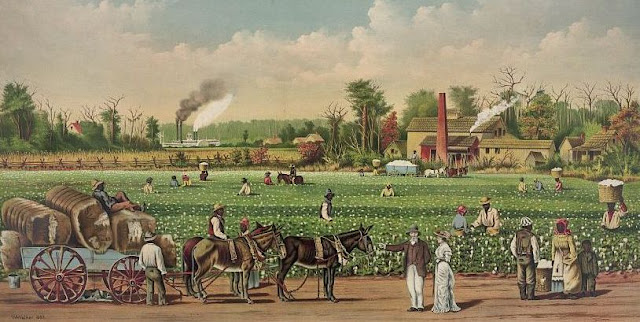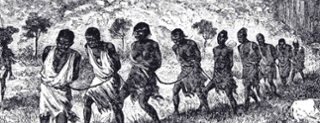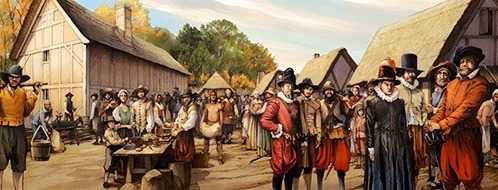
Southern Colonies Economy
Growth in Economic Activities
Virginia was the first successful southern colony, succeeded by the establishment of Maryland. These two early southern colonies are known as Chesapeake colonies. For at least two generations early southern colonies economy was mainly based on small farms, although commercial cultivation of tobacco started with small scale plantation 1620 onwards. Unlike early colonies, later southern colonies economy did not developed from small farming background.
The establishment of later southern colonies of Carolinas after English Civil War (1642-51) and Georgia, the last of the original thirteen colonies witnessed large scale arrival of the colonists.
Most of the Carolina colonists were rich aristocrats or businessmen, who wanted to acquire more wealth with holding large portions of land. Huge cash corps plantations were established throughout southern colonies, specifically in the Carolinas. Commercial plantation of cotton, tobacco, rice and indigo had made the Carolinas (after 1712 South Carolina) one of the wealthiest colonies and south the wealthiest British American colonial region.
Threat from Spain in Florida and France in Louisiana led King George II to design a buffer zone between the cash crops of South Carolina and foreign enemies. James Oglethorpe, started Georgia, as a debtor’s refuge (an alternative to English debtors’ prison) in 1732 and fulfills that need. Soon these “unfortunate wealthy people” from England brought fortune to Georgia, as well as for themselves.Southern Colonies Economy
Agriculture
Plantations
Some of the colonist became owners of large areas in southern colonies. They were able to engage in grand plantations due to rich soil and the warm weather of the region. The huge plantations required many workers. Other than just working in the fields, plantations tended to all year long, creating different jobs.
It was hard for plantation owners to find people to work the farms. Early colonial plantation owners used indentured servants, which were gradually replaced by slaves from Africa, although not totally. The plantations were generally designed near the ocean or rivers to help with shipping their cash crops to other colonies or countries. Being wealthiest in southern colonies, planters and their families enjoyed a secure and luxurious life of the contemporary world.
Small Farms
No doubt that the landscape with great plantations had made southern colonies and planters wealthiest. But most of the soils of southern colonies were still full of small farms. Beyond the coastal plains and further inland there was backcountry and piedmont with small family farms, spreading throughout southern colonies.
Generally the farm owners used to work their respective fields, with only a few fortunate having help of indentured servants or slaves. Apart from the fact that education for their children remained a day dream, lack of good transportation generally resulted in loss from farming occupation.
Both, planters and English government accumulated grand wealth, especially from tobacco plantation. But even most tobacco growing colonies of Virginia and Maryland’s small farmers did not get their profit. Being further from the towns also caused high death rate among backcountry people, having no access to easy and basic medical facilities.
Southern Colonies Economy
Indentured Servants and Slaves
The plantation based southern colonies economy would require a labor force. Although present in the North, slaves and indentured servants were much more important to the South, being the backbone of the cash crop growing southern colonies economy.
Indentured Servants
As soon as the great potentiality to become wealthy from plantation is realized by large landowners, the demand for great work force is raised. But opposite to England there was plenty of land, but not enough people to work the land. As a result, many of the landowners, who lost their land in England or did not own desirable amount of land move to southern colonies to start fresh, hoping great pieces of land in future. These willing people, who came from England and other parts of Europe to work for big landowners, are known as indentured servants.
In return of providing transportation to North America, food, shelter and clothing; these indentured servants were bound to work on the landowner’s plantation or farm for a period of 4 to 7 years to repay their debt owed to the landowner.
An indentured servant was recognized a free person but made agree to work for another person for free. An indenture or a contract was signed between the willing person and his landowner, stating the terms of the agreement.
Freedom dues was given, which could include clothing, seeds to start their own crop, or a gun once the indentured servant had worked for the period of time agreed upon in their indenture. Some were fortunate enough with getting a piece of land.
But in most cases, in the hands of dishonest and greedy landowners the practice brought following results for the servants:-- Many indentured servants used to work hard to pay off the debt that the owner had paid within one year to become free. But they were not freed on the basis of period mentioned in the contract.
- Due to disease and poor nutrition, many indentured servants did not survive to work through their indentured servitude of 4-7 years. The situation was made worst with owners pressurizing their servants to overwork, to get the most for their money.
- After surviving 4-7 years of work, many indentured servants had not earned any money. As a result, with inability to support themselves, they were forced to begin a new indenture.
Landowners used to receive 50 more acres of arable land, with paying for the indentured servant. So there was always increasing demand for workforce. No doubt that this benefit made it a dishonest but profitable practice for large farm and plantation owners, which brought sorrow for a greater number of indentured servants.
Slaves
Plantation was always an ever expanding process in southern colonies. As a matter of fact there was growing demand for slaves. Indentured servants alone could not meet the need of more labor force for plantation owners. Thus slave trade found its profitable market in southern colonies. A farm economy that could not survive without slave labor was developed in southern colonies.
Slaves were captured and brought to America, mostly from Africa. They were considered the property of the person who bought them. It was 1619 when the first slaves were purchased in Jamestown. The improvement of British economy by 1680, with providing more employment opportunity had made slavery a necessary instrument for southern colonies economy.

Slaves were treated very cruelly. They were often beaten and forced to complete difficult work over the course of many hours each day on plantations. A child born from a slave was also considered a slave. Totally deprived of education, a slave child was put to work as soon as he became able to do so. Otherwise he was sold as a slave to another owner.
The southern colonies remained dependent on the free labor of slaves to be successful and eventually would become the major reason of American Civil War.Southern Colonies Economy
What did the southern colonies trade?
What did the Virginia colony trade?
Tobacco, cotton, rice, indigo (dye), lumber, furs, farm products, corn, vegetables, clay and bricks.How did Maryland colony make money?
From tobacco, cotton, rice, indigo (dye), lumber, furs, farm products. Iron industry and shipbuilding also earned revenue for Maryland.What did North Carolina colony trade?
Cotton, rice, indigo (dye), lumber including tar, pitch and turpentine, furs, silk, barrel staves, tobacco and farm products.What did South Carolina colony trade?
Cotton, rice, indigo (dye), tobacco, lumber, furs, farm products, silk and grapes and raisins.What did Georgia colony trade?
Tobacco, cotton, corn, rice, sugarcane, indigo (dye), lumber, furs, barrel staves, pottery, farm products.Southern Colonies Economy
Urban Centers
Major Urban Centers in Southern Colonies

- Perkins E.J (1983), The Economy of Colonial America.
- Craven W.F. (1949), The Southern Colonies in the Seventeenth Century.
- Steeg C.V. (1964), The Formative Years.
- Andrews C.M. (1934-37), The Colonial Period in AmericanHistory.
- Smith A. (1982), The Wealth of Nations.
- Bolton H.E and Marshall T.M. (2015), The Colonization of North America 1492-1783.
Comments
Post a Comment